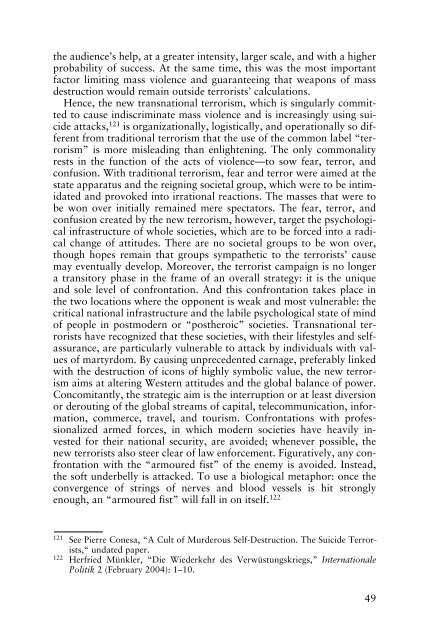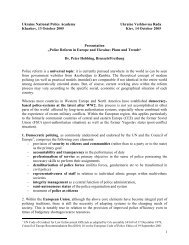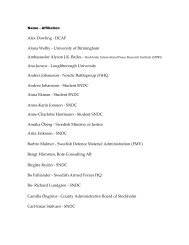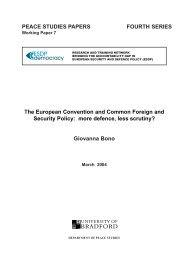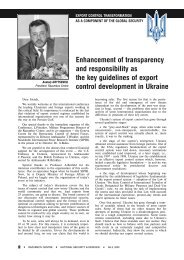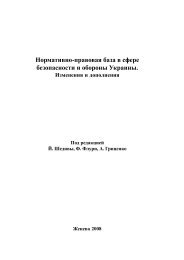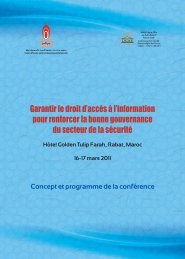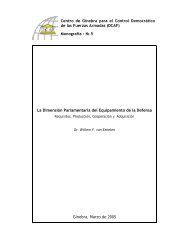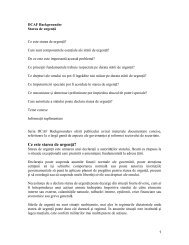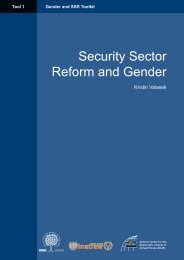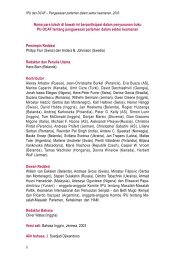combating terrorism and its implications for the security sector - DCAF
combating terrorism and its implications for the security sector - DCAF
combating terrorism and its implications for the security sector - DCAF
You also want an ePaper? Increase the reach of your titles
YUMPU automatically turns print PDFs into web optimized ePapers that Google loves.
<strong>the</strong> audience’s help, at a greater intensity, larger scale, <strong>and</strong> with a higher<br />
probability of success. At <strong>the</strong> same time, this was <strong>the</strong> most important<br />
factor limiting mass violence <strong>and</strong> guaranteeing that weapons of mass<br />
destruction would remain outside terrorists’ calculations.<br />
Hence, <strong>the</strong> new transnational <strong>terrorism</strong>, which is singularly committed<br />
to cause indiscriminate mass violence <strong>and</strong> is increasingly using suicide<br />
attacks, 121 is organizationally, logistically, <strong>and</strong> operationally so different<br />
from traditional <strong>terrorism</strong> that <strong>the</strong> use of <strong>the</strong> common label “<strong>terrorism</strong>”<br />
is more misleading than enlightening. The only commonality<br />
rests in <strong>the</strong> function of <strong>the</strong> acts of violence—to sow fear, terror, <strong>and</strong><br />
confusion. With traditional <strong>terrorism</strong>, fear <strong>and</strong> terror were aimed at <strong>the</strong><br />
state apparatus <strong>and</strong> <strong>the</strong> reigning societal group, which were to be intimidated<br />
<strong>and</strong> provoked into irrational reactions. The masses that were to<br />
be won over initially remained mere spectators. The fear, terror, <strong>and</strong><br />
confusion created by <strong>the</strong> new <strong>terrorism</strong>, however, target <strong>the</strong> psychological<br />
infrastructure of whole societies, which are to be <strong>for</strong>ced into a radical<br />
change of attitudes. There are no societal groups to be won over,<br />
though hopes remain that groups sympa<strong>the</strong>tic to <strong>the</strong> terrorists’ cause<br />
may eventually develop. Moreover, <strong>the</strong> terrorist campaign is no longer<br />
a transitory phase in <strong>the</strong> frame of an overall strategy: it is <strong>the</strong> unique<br />
<strong>and</strong> sole level of confrontation. And this confrontation takes place in<br />
<strong>the</strong> two locations where <strong>the</strong> opponent is weak <strong>and</strong> most vulnerable: <strong>the</strong><br />
critical national infrastructure <strong>and</strong> <strong>the</strong> labile psychological state of mind<br />
of people in postmodern or “pos<strong>the</strong>roic” societies. Transnational terrorists<br />
have recognized that <strong>the</strong>se societies, with <strong>the</strong>ir lifestyles <strong>and</strong> selfassurance,<br />
are particularly vulnerable to attack by individuals with values<br />
of martyrdom. By causing unprecedented carnage, preferably linked<br />
with <strong>the</strong> destruction of icons of highly symbolic value, <strong>the</strong> new <strong>terrorism</strong><br />
aims at altering Western attitudes <strong>and</strong> <strong>the</strong> global balance of power.<br />
Concomitantly, <strong>the</strong> strategic aim is <strong>the</strong> interruption or at least diversion<br />
or derouting of <strong>the</strong> global streams of capital, telecommunication, in<strong>for</strong>mation,<br />
commerce, travel, <strong>and</strong> tourism. Confrontations with professionalized<br />
armed <strong>for</strong>ces, in which modern societies have heavily invested<br />
<strong>for</strong> <strong>the</strong>ir national <strong>security</strong>, are avoided; whenever possible, <strong>the</strong><br />
new terrorists also steer clear of law en<strong>for</strong>cement. Figuratively, any confrontation<br />
with <strong>the</strong> “armoured fist” of <strong>the</strong> enemy is avoided. Instead,<br />
<strong>the</strong> soft underbelly is attacked. To use a biological metaphor: once <strong>the</strong><br />
convergence of strings of nerves <strong>and</strong> blood vessels is hit strongly<br />
enough, an “armoured fist” will fall in on <strong>its</strong>elf. 122<br />
121 See Pierre Conesa, “A Cult of Murderous Self-Destruction. The Suicide Terrorists,“<br />
undated paper.<br />
122 Herfried Münkler, “Die Wiederkehr des Verwüstungskriegs,” Internationale<br />
Politik 2 (February 2004): 1–10.<br />
49


